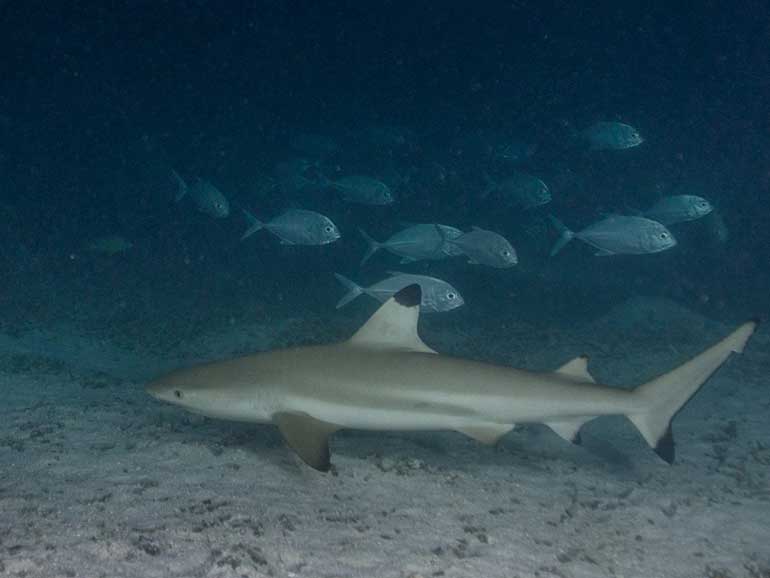I was delighted to see our two new members, Devon and Justin, return for their second consecutive Bubbles of Hope trip! It brought me so much joy to watch them dive back into the experience, and I couldn’t be more pleased that the group is offering them the chance to dive more regularly than they’ve ever had the opportunity to before. It’s amazing to see how these trips are not only reconnecting them with the wonders of the underwater world, but also allowing them to grow and deepen their appreciation for it with each dive.
I was also accompanied by Mischa, who brought along her 10-year-old brother, eager to experience the wonders of the ocean. It was a truly memorable moment when he took his first breath underwater, his excitement and curiosity shining through as he plunged into the sea for the very first time. Seeing the joy in his eyes reminded me of the powerful connection we all share with the underwater world. There’s something incredibly inspiring about introducing people to the beauty of the ocean and the exhilarating world of diving.
The Discover Scuba Diving Experience is designed to be taken by people who have never done any scuba diving but would like to know what it feels like before committing to the learning and certification courses. One of Scuba Junkie’s PADI Professionals Zoe took him aside while we were gearing up for our cleanup and explained some of the basic dive gear, how to use it, and went over some of the skills they would do in the water.
We were already underwater by the time he did his first backroll without hesitation; quite an impressive feat! This entry into the water is symbolic of his first milestone as a new scuba diver. Zoe took him to the very shallow waters in which he could easily stand up to get him comfortable breathing in the regulator and performing some simple skills. Maybe a Bubbles of Hope participator in the making!
The four of us led by Jason and Alex were busy picking up plastic packaging, plastic cups, and of course, plastic bottles. Two big mesh bags were filled up within 30 minutes! We were diving in the Sapi House Reef which is our favourite spot to find the most trash, however, I’ve definitely noticed a reduction; where there used to be piles and piles of bottles, there is now scattered trash buried in the sand every few meters. Not sure if this was just because the current washed out the rest or if we headed in a different direction, but overall the dive site seemed more cleared up.
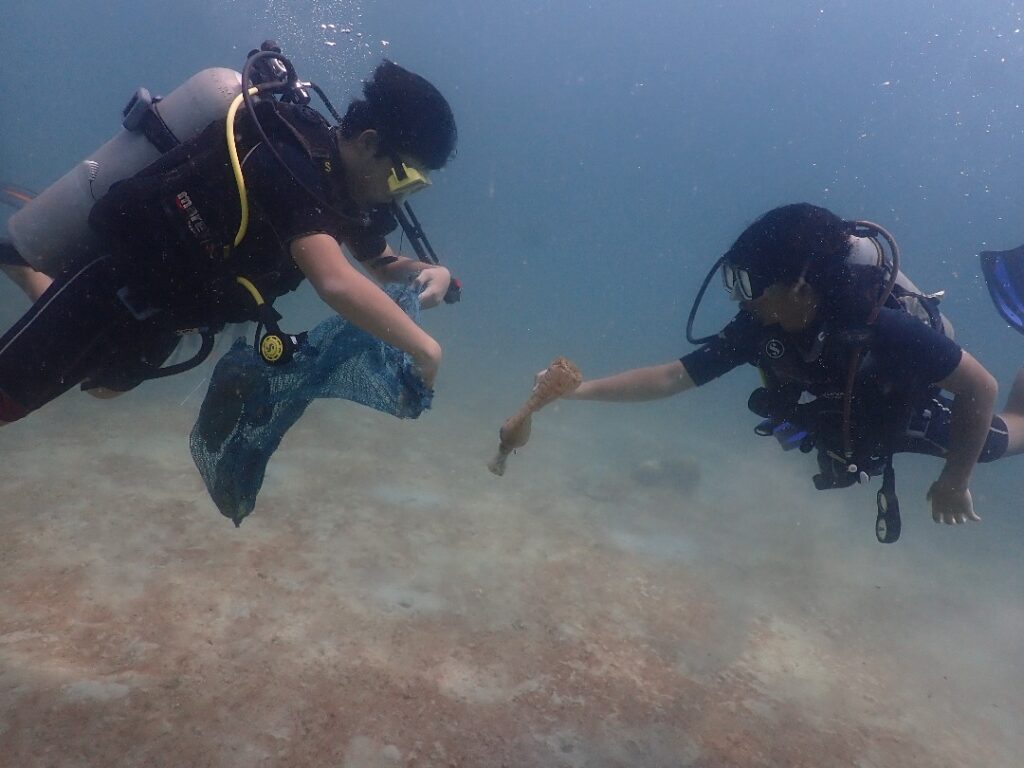
Jason headed up first with Devon, and the rest of us came back up later. As soon as we surfaced, they told us that a moray eel who had been residing in one of the plastic bottles had slithered out once on the boat, and had fled back to the safety of the water. This doesn’t happen very often, and we always remind ourselves during the briefing to shake out any bottles, however it’s almost inevitable to not get the odd critter here and there – although this will be the first time I ever hear of a moray eel sneak out!

After an exhilarating dive around the pristine waters at the back of Sapi Island, where Mischa’s brother also had the chance to explore the vibrant marine life, we enjoyed – as always – a delicious, well-deserved lunch. The warm sun and the peaceful rhythm of the waves seemed to recharge us. As we made our way back to the mainland, we were tired but fulfilled, knowing that once again, we had managed to contribute just another little droplet to a sea of change, continuing our journey toward making a lasting impact, one step at a time.
‘Til the next one! With the promise of more adventures, more impact, and more unforgettable moments waiting just around the corner.
Written by Julia
Kota Kinabalu, the lively capital of Sabah on Malaysia’s Borneo island, is a hidden treasure for scuba diving enthusiasts. Known for its crystal-clear waters, vibrant coral reefs, and diverse marine life, it’s no wonder this region has become a diving hotspot. At the heart of this underwater paradise is Scuba Junkie, one of the top dive operators in the area.
Whether you’re a beginner taking your first plunge or a seasoned diver exploring new depths, Scuba Junkie offers a world-class diving experience focused on safety, sustainability, and exceptional service. In this guide, we’ll take you through everything you need to know about diving with Scuba Junkie in Kota Kinabalu—from booking your dives to discovering some of the most breathtaking dive sites in Borneo.
Before we dive into the details, let’s take a moment to understand what makes Scuba Junkie a standout choice for divers.
Booking your dive is a straightforward process, but there are a few things to know to ensure you get the most out of your experience.

A typical dive day with Scuba Junkie is an exciting, well-organized experience that prioritizes both fun and safety.
Before heading out, the team will conduct a detailed briefing, covering the dive sites, conditions, and safety protocols. This ensures that everyone is on the same page and ready to dive safely.
Scuba Junkie’s dive boats are comfortable, equipped with all the necessary safety equipment, and well-maintained. The boat ride to your dive site is typically short—most dive spots around Kota Kinabalu are just 15 to 30 minutes away from the Jesselton Point.

Scuba Junkie offers dives at various sites around Tunku Abdul Rahman Marine Park including islands like Manukan, Sapi,Mamutik, Sulug and Gaya. Each site is known for its unique marine life and vibrant coral reefs, ranging from shallow, easy-going dives to more challenging dives.

Expect to encounter a variety of marine life, including:
After your first 2 dives, you’ll return to the island for lunch and a chance to relax. Then head out for a third dive before heading back to the mainland.
If you’re looking to get certified or improve your diving skills, Scuba Junkie offers a range of PADI courses, including:

Diving with SJ in Kota Kinabalu is not just about exploring some of the most beautiful underwater landscapes in the world. It’s about supporting an eco-conscious operator committed to sustainability and safe diving practices. Whether you’re a beginner looking to get certified or an experienced diver eager to explore vibrant coral reefs, SJ offers something for everyone.
So, if you’re planning a dive trip to Kota Kinabalu, make sure to contact Scuba Junkie for an unforgettable underwater adventure!
Book your next dive trip with SJ KK today and experience the magic of diving in Borneo!
If you follow me on social media, you may have seen a tribute post for the Bubbles of Hope members. I thought it would only be fair to give them a shout out on this blog too.
The group had its very first cleanup on the 2nd April 2022. The goal was to get out once or twice a month, but I quickly realised it wouldn’t be as easy. First I had to find young divers eager to join to help me make a difference. To find them I started scouting in my class by simply asking, and extended it to my whole school with a poster set up in the hall and later distributed by the teachers to the targeted year groups. A letter published in our weekly newsletter was also shared in hope to reach both students and parents. As I had joined several reef cleanups myself where I was the only minor, I really wanted this group to be made up of teens only, from 10 to 17 years. Little by little some students accepted to be part of Bubbles of hope, making it official by purchasing the t-shirt with the logo I had designed.
Today, Bubbles of Hope has 11 members, from 11 to 16 years. Mostly – but not only – from my school. I knew one of them from outside school, and I was very happy to receive a request from a homeschooled teen girl traveling around the world, currently based in KK. She had come across a post about this group and was eager to join! Did I mention I also have four pairs of siblings which is absolutely awesome; not to forget two sisters who have since then moved overseas but regularly come back and make a point to do a reef cleanup with us.

Unfortunately gathering everyone on the same day happened to be quite tricky. Young people are definitely busy during the weekends, despite what people might think. Tuition, classes, family plans… We still haven’t had a chance to be all together at once. But with a bit of luck and eagerness we did manage to achieve 12 cleanups in 17 months and I couldn’t be more grateful for that. I also wanted to highlight one of my IG followers, a fellow young diver from England who messaged me that she was very inspired by our group. She decided to do some cleanup herself in the nearest park to her house with a friend and sent me the video, since diving is not as accessible for her as it is for us. I couldn’t be more happy to know our group can reach youth literally across the world who are inspired enough to do their part. The saying do good and good things will come back is very true in our case. What better reward than bumping into a turtle, some shy reef shark or even a whaleshark like we did at the beginning of this year!
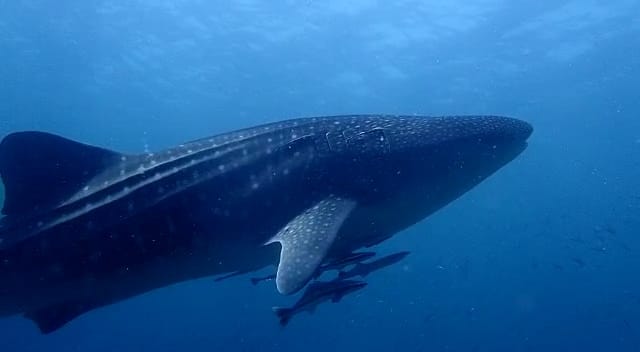
Glad to announce we have two new members ready to join. I said it before but I can say it again: Bubbles of Hope is constantly looking for young divers to join us. Thanks to Scuba Junkie Kota Kinabalu we have a boat, a captain and divemasters ready to support us. I hope more youth will be onboard in the future. I know this project might feel like a drop in a huge ocean but I believe anything is better than nothing – and I definitely hope that this will create a continued wave of change in each of our members’ lives. We are very lucky to live in a place where the temperature above and underwater are really tropical all year long; the marine park is 10-15 minutes away. I know how lucky we are and I believe it would be a shame not to give back to the environment with these idyllic conditions. Each piece of trash/plastic removed makes it feel better and gives us a purpose as young divers.
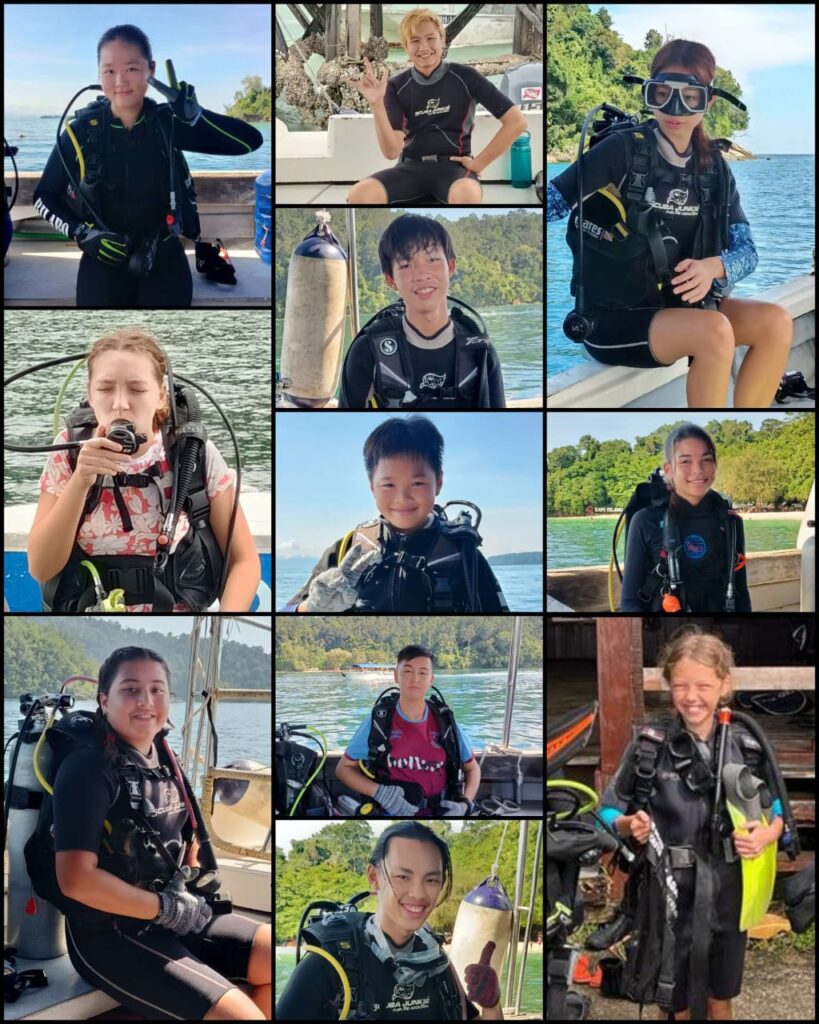
As always, looking forward to the next time I can meet up with my cleanup gang and we can not only make a difference, but have a blast while doing so. Julia
Saturday 16th September was both Malaysia Day and International Coastal Cleanup Day. A good excuse for Bubbles of Hope to go out again and enjoy the beauty of our Sabahan underwater world while chasing any trash that is polluting it. After all, even if ‘coastal’ refers to the border next to the sea, we have to remember that pollution has no such boundaries and eventually ends up deeper in the ocean.
Five of us boarded one of Scuba Junkie’s boats with Jason and Alex, our two DMs for the day. With optimal conditions – water temperature 30°C and visibility up to 15 meters we were in for a great day, ready to do our part, and have fun!
Very happy to report our first dive site was clear of trash! After 45 minutes of trash hunting, we came back with empty mesh bags except for one plastic bottle. The kind of failure that feels like a victory. Pik Yen and Isabella even found time to play rock, paper, scissors to celebrate during our safety stop 😉
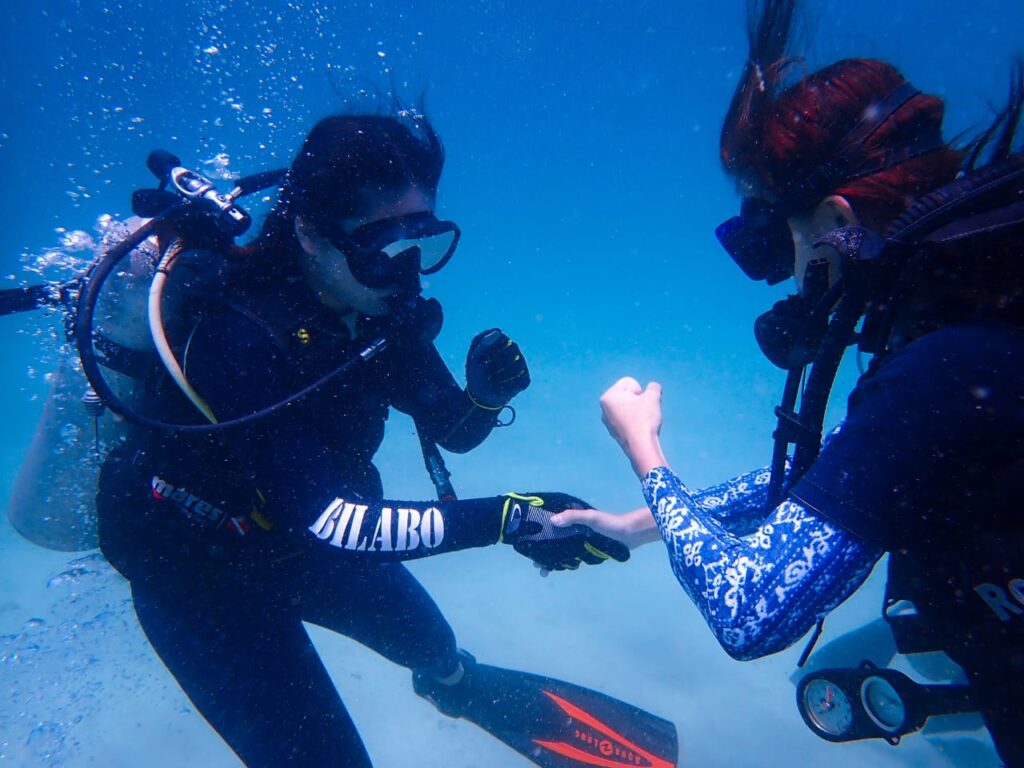
A quick snack and then onto a small cove of white sand that looked empty from afar. But behind the big tree roots lots of plastic bottles, packaging and diapers were there, ready to stay for the next hundreds of years. When plastic takes over nature, nobody wins. We removed 3 big trash bags before it was time to head out again.
After the second dive – no trash either – and lunch, we decided to use our free time on the beach to have some fun.
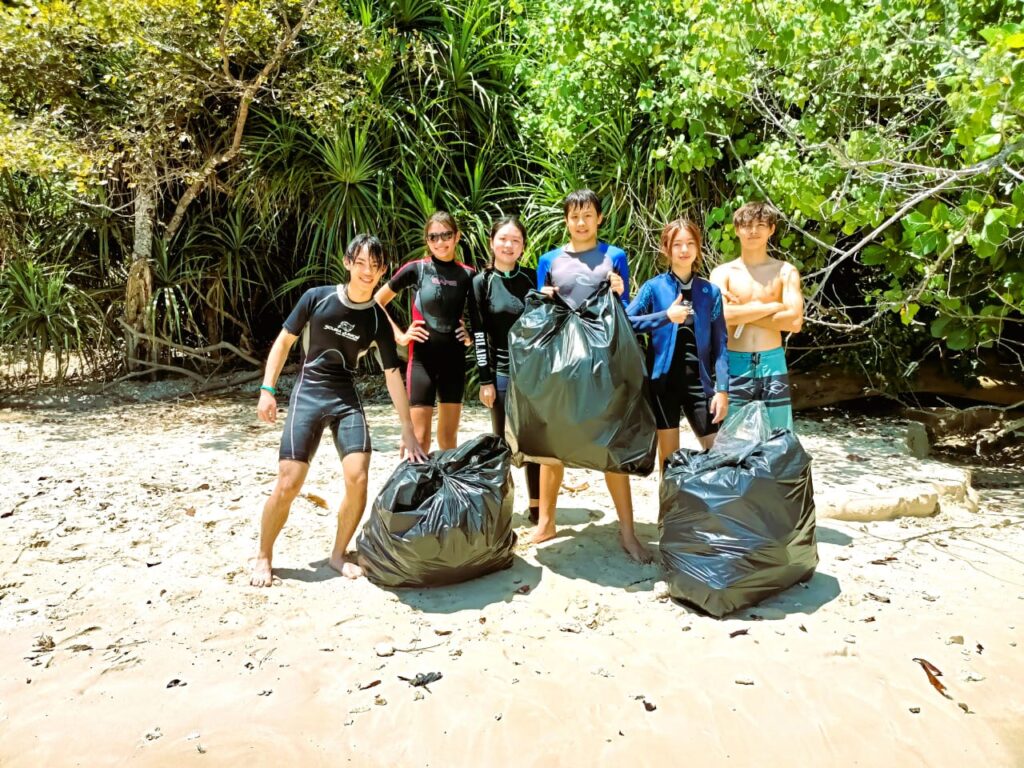
Work hard, play harder
Let’s not forget that Bubbles of Hope is a group of teen divers. And although it may sometimes sound like tedious work to remove trash, we actually have a lot of fun in the process; both under and above the water.
Once the diving part is done, there remains a group of young people who just want to keep the fun going. Give us a beach, a bit of sun and a beach ball, and we will make the best of it. Sand in my hair was all worth it after an epic battle of sand balls, as we all left with a huge smile on our faces. To me, there’s no better sight than to see youth reconnecting with nature, having fun, and bonding together – a luxury that we never take for granted.
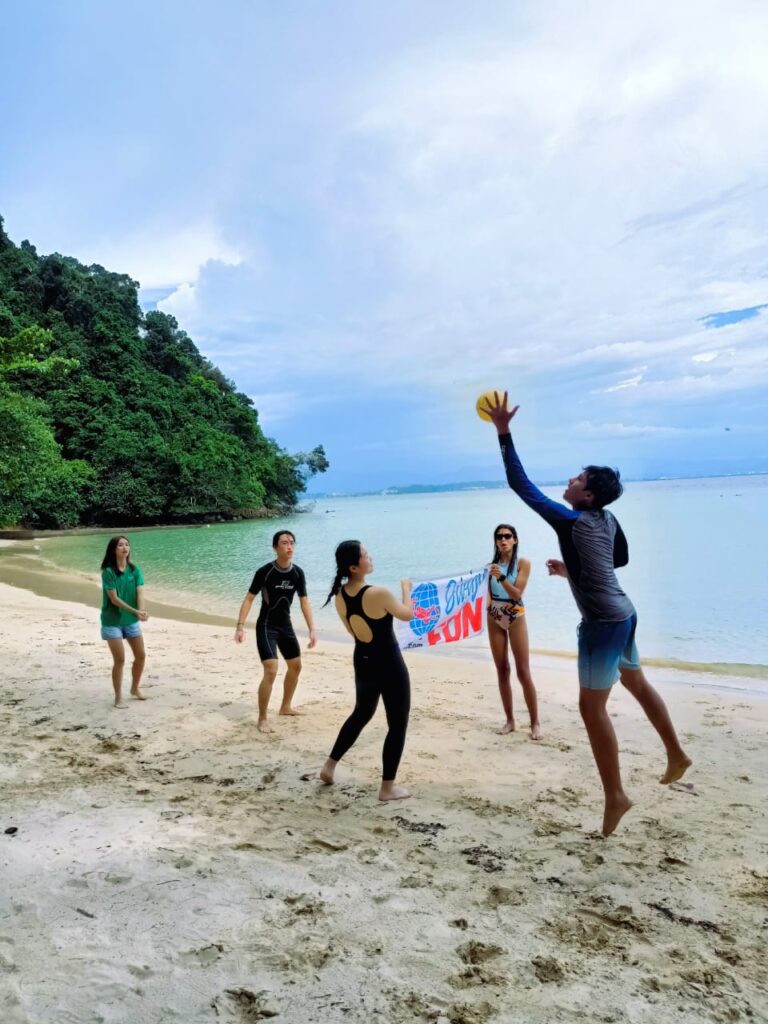
Overall, we may not have found so much trash underwater, but to me this trip was a success yet again. We still managed to do our part for the park and the fun that we had that day was a reminder of why we are protecting such an amazing place.
Bubbles of Hope #12 was a blast! Definitely looking forward the next one…
Julia Rabenjoro
Saturday 16th marked the 10th Bubbles of Hope reef cleanup done and a very special one for multiple reasons.
As usual, our day started at the Jesselton Point Jetty, heading off under the bright sunshine and blue skies. Our first dive site was Sulug House Reef where we immediately ran into ‘Bumpy’ the residential humpback hawksbill turtle. Shortly after, we emerged from the warm waters with a bag full of trash collected from the sandy bottom and headed to a small, secluded island for our surface interval.
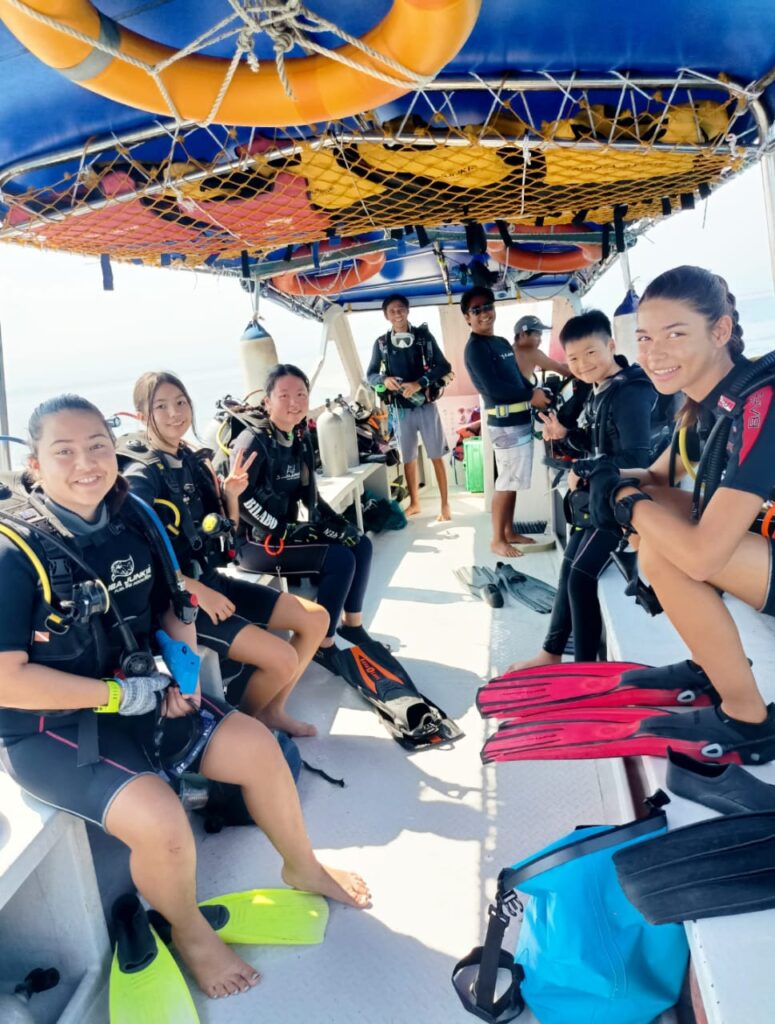
Normally, we would do a beach cleanup in this exact location, but today was a special day as it was the last time we would be diving with one of our divemasters/buddy, Awie, for a while. And so instead, we ate some cakes kindly brought in by Pik Yen, one of our teen divers.
It wasn’t long before we were heading off again to our fun dive yet again near Sulug Island. As we hurried to get into the tropical waters, no one expected what was to come…
The visibility was incredible – probably the best one I’ve seen in the park – and we excitedly roamed the top reef before coming to the slope where we followed a humongous school of bigeye snappers on our right shoulder. We continued along the edge, finding beautiful block corals, soft corals and an adorable, vibrant purple nudibranch.
Eventually, the visibility seemed to get a little foggy, and we headed back the way we came, running into our school of snapper friends again and taking many more pictures and videos. At last, in exactly the right location at the right time, a spotty shadow loomed towards us from the blue. The shape and pattern was undeniable: we had run into a whale shark mid-dive!
Squeals of joy, denial and disbelief bubbled to the surface as it looped around us slowly, yet efficiently, and we took as many pictures and videos as our cameras could hold. After it had faded away into the blue again, the magical feeling still lingered and each mask had wide eyed gazes.
Shortly after that, a chubby black tip reef shark came by just to make the dive even more incredible then it had already been, and we resurfaced in cheers and awe.
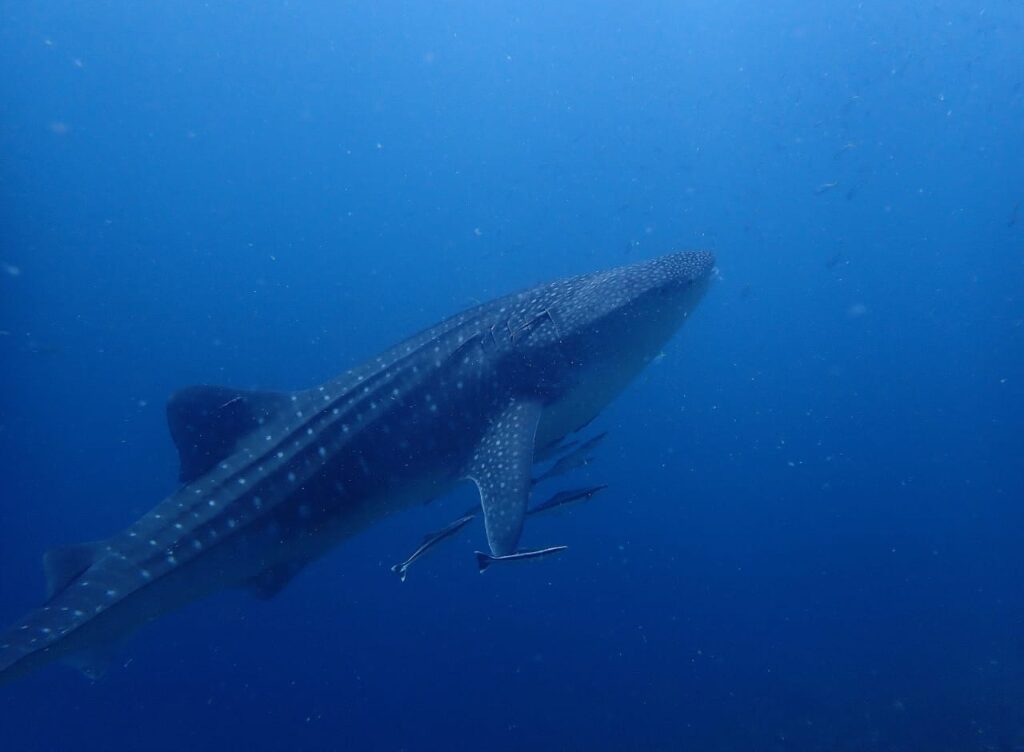
As we headed to lunch, there was no other topic of discussion but endless recounting of funny reactions and excitement as we rewatched the videos captured.
After lunch, logbooks were filled with drawings and bold titles of ‘WHALE SHARK!” and it was so amazing to think that for Isabella, one of the teen divers, this had been her very first encounter with one of these majestic creatures. And for Lung Ip who is only 11, this had been his second time in only 35 dives! A special dessert was the cake that I baked as a goodbye to Awie and each of the present members had signed it with a short message.
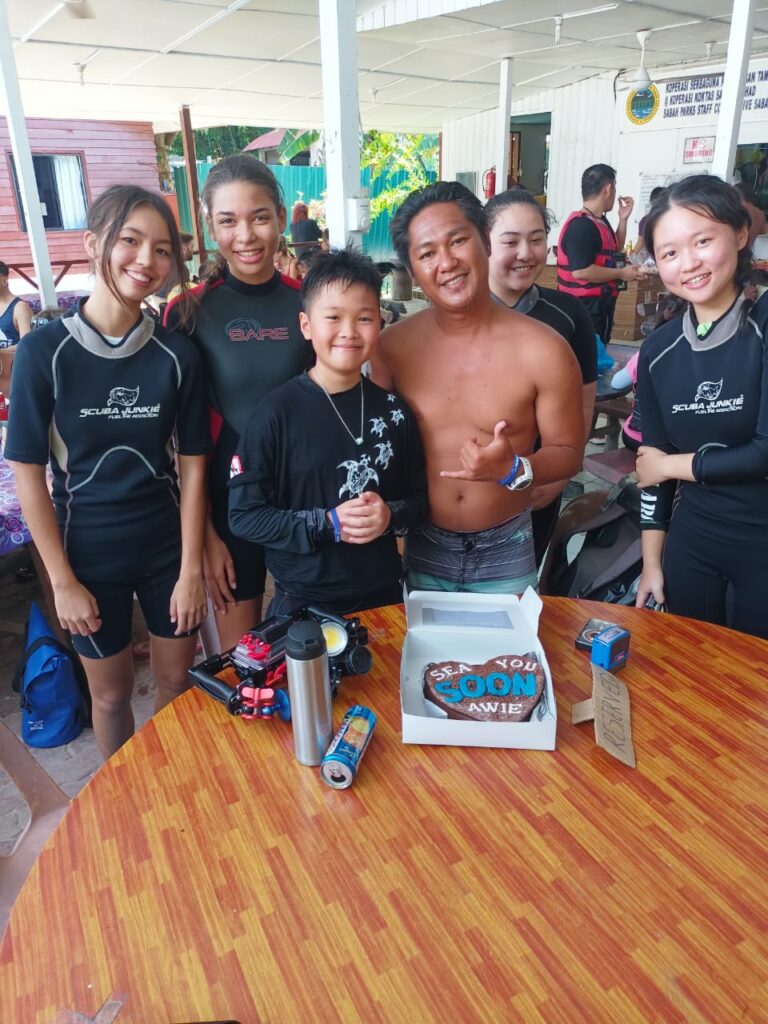
Nothing but happiness and stories returned to the shocked parents. This was an amazing reminder of what we are doing these cleanups for. It was a real-life (unexpected!) encounter with one of our rarest marine neighbours and it was just the most perfect way to send off Awie and to celebrate our 10th Bubbles of Hope dive trip!
I am very much looking forward to many more to come, and am more than ever motivated to help clean up our watery home.
Happy Bubbles!
Julia (Bubbles of Hope)
One of the most common things we teenagers hear from our parents is “Clean your room!” and “Pick up your stuff!” And let’s be honest, we suddenly have hearing problems and a million other priorities…
But when it comes to cleaning up underwater, it’s a different story. My name is Julia. I am a 15 year old PADI AmbassaDiver and a Junior Master Scuba Diver.
A few months ago I had the idea to gather young divers to dive with a purpose. After all, it’s never too early to start. After 7 years of scuba diving in the Tunku Abdul Rahman Park, seeing trash floating or stuck underwater and noticing more and more kids being certified, I thought: how cool would it be to join forces and do something good for the ocean!
I created a logo, found a great printer shop and Bubbles of Hope was born.
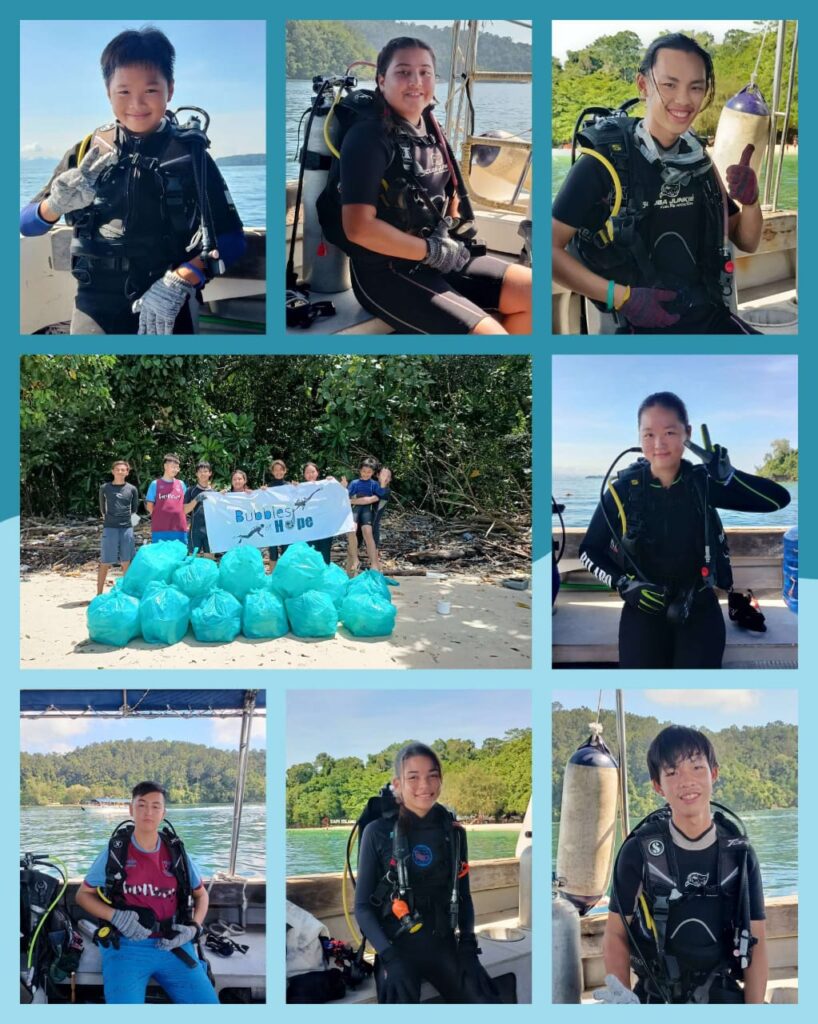
It’s not always easy to find the right day to accommodate everyone but also not impossible. Partnering with local dive centers is much easier and I am so grateful for that!
Scuba Junkie immediately accepted to jump on board and hosted our 6th reef cleanup last month.
There were 7 of us meeting up at Jesselton by 8am (yes, teens can wake up early during the weekend for a good cause!) and off we go, wearing our Bubbles of Hope t-shirts! Everyone is chatting and excited, the sun is shining brightly and with Awie and Jason, I know we are in good hands. Briefing, gearing up, mesh bags ready, one by one we are back rolling into Sapi House reef.
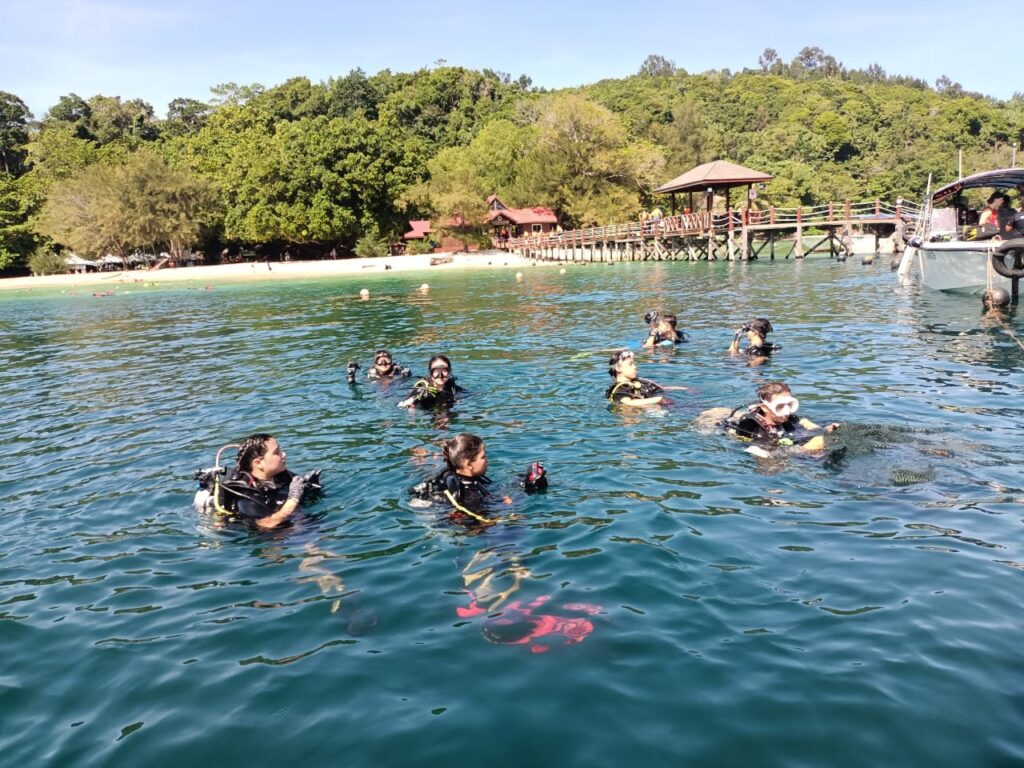
Split in 2 groups we worked together, keeping our buoyancy in control and helping each other out and had a pretty bitter-sweet outcome. Very sad to have seen so much trash but glad that we were able to get 3 and a half large mesh bags of rubbish out of there!
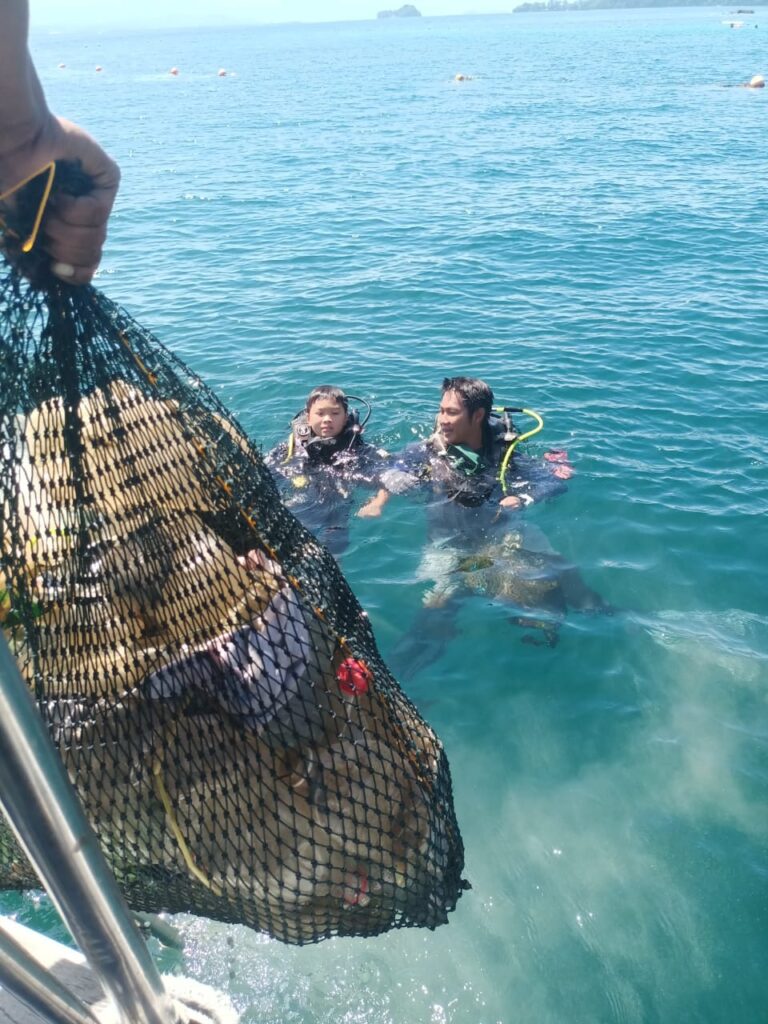
We used our surface interval to head to an occupied beach where we got to work on the mounds upon mounds of plastic bottles, food packagings and polystyrene that had washed up on the beach and in the vegetation. Led by our 2 dive masters we created an organized system to collect, crush and bag up as much trash as we could, and despite the time and limited workforce, we were able to get 16 bags of rubbish off that beach! We even had the unexpected help from a nice couple who were chilling with their own boat and were happy to give a hand. I hope the macaque who was watching us from afar appreciated our collective efforts. Of course, there was still a lot left so we’ll be back! Then we headed to Gaya Island, where we took a break from pollution to go on a fun dive and enjoy the beauty of the park we are working so hard to preserve! Cameras were out and lots of vibrant, colourful coral and fish were spotted.
Exhausted but satisfied with our work for the day, we headed to the other side of the island for a delicious, well deserved lunch followed by a peculiar competition of sand balls and leisure swims in the warm, tropical waters.
It was a very productive day and it’s so promising to see such interest and dedication reflected in this group.
So yes, we might not be the champions of cleaning our bedrooms but I can tell, we did a pretty good job with Scuba Junkie! And it’s just the beginning…
Please get involved! If you are/know any PADI certified teen divers (10-17 years old) who might be interested to join, don’t hesitate to contact me for more details on:
Instagram: @julia_into_the_blue
Facebook: Seed of Hope
Email: juliaintotheblue@gmail.com
If you aren’t a diver, then please show your support to our efforts by checking out the social media handles or spreading the word about this project. The more people we have, the bigger difference we can make!
I hope to see you underwater! Keep diving and happy bubbles! Julia
Do you still remember the time when you first took your Open Water certification? If yes then you will surely remember the time where your instructor taught you how to log a dive properly after you finished your dive. Most divers only came to know about a dive log when they take their Open Water course while some already have had experience with it during Discover Scuba Diving. Some of the divers still keep an active dive log after years of scuba diving. However some no longer do it as soon as they complete their course. So should you keep a dive log? and why should you keep a dive log? Have a read at the below 6 reasons why a dive log is important.
The first important reason why you should keep a dive log is as a proof that you are an experienced diver. While a certification card is enough to prove you as a qualified diver to go diving, you will need a dive log to advance to the next level. All major diving organisations require divers to have a minimum number of logged dives in order to enrol in some of their diving courses. This is especially important if you are thinking of going pro in your diving career as you will need to reach a certain number of dives before you can begin the Divemaster or Instructor course. So having a dive log is a proof that you are an eligible candidate for the course.
Having a dive card is simply not enough when you go diving sometimes. This is due to the diving conditions being a bit challenging in some places. Therefore dive shops will need to make sure that you have enough experience to do the type of diving that you are planning to do. Liveaboard’s may ask you to show your dive log before you can go on their boat.
Diving is a lifelong learning process. You might feel nervous & make a few mistakes during the first couple dives. The only way for you to improve yourself is if you keep a dive log. You can write down the difficulties that you faced during a dive and discuss it with your buddy or the guide after a dive. Those few tips from them can help you to stay longer and become more comfortable in the water in the future. You learn something different with every dive. Logging a dive will help you to identify the skills that you need to work on so that you can have a more enjoyable diving experience. From how to control your breathing, managing your buoyancy underwater to even fish identification! There is always room for improvement regardless of the number of dives that you have under your belt. Logging a dive can help you to keep track of your learning progress & become a more confident diver!
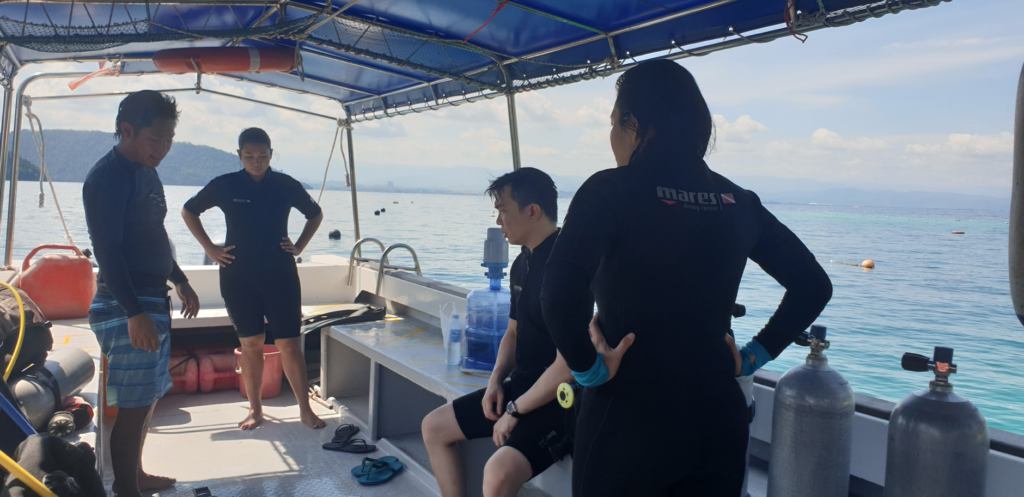
A dive log is just like a passport for a diver. It is full of different stamps from different dive shops around the world. A lot of divers love to collect dive stamps as it helps them to remember all the places that they have dived in. Each dive shop has their own unique stamps. An instructor or guide will usually sign & stamp your logbook after each dive. It’s a proof that you have gone diving with them. You can always start a conversation with your diving buddy by showing them the dive stamps that you have collected. Sharing dive stamps with your buddy is definitely a fun topic to talk about after an amazing day of diving!
Diving equipment is vital for divers underwater. The equipment can vary slightly depending on the water temperature & diving condition of the area that you have visited. The different types of diving suits that you wear can affect the amount of weight that you need. You will waste a lot of time experimenting with different weights until you obtain neutral buoyancy. This won’t be a problem if you record all your dives. By doing so, all the information in your logbook can serve as a reference for your future dives in all kinds of situations. You can make the most from your dive when you don’t need to waste time adjusting your gears for each dive.
We have to understand that there’s a limit to a human’s memory. You won’t be able to remember all the dives that you have done in the end. However keeping a dive log can preserve all those beautiful memories for you, which is why many divers use their dive log as an underwater diary. You can record everything about the dive in your logbook. For example, what did you like about the dive, what makes you feel uncomfortable under the water, what marine life that you have seen & so on. You will be able to look back all the details and great memories of each dive trip.
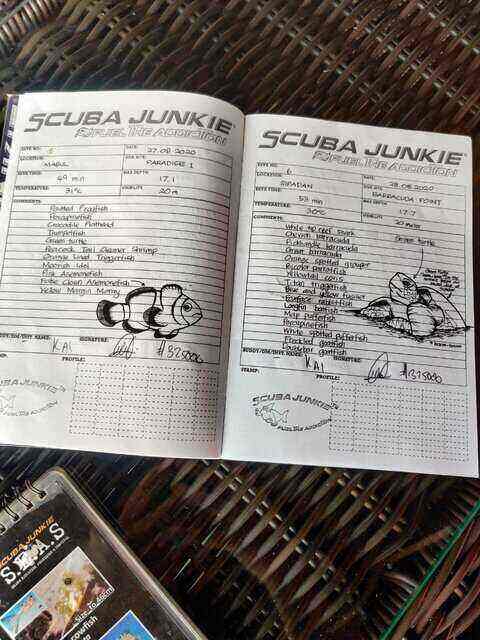
It is not necessary to have a dive log for fun diving, at the end it’s just merely a personal choice. But we hope the reasons above will make you start to log your dives as it definitely brings more good than harm to you and will remind you of all the great dives you have had!
Here at Scuba Junkie Kota Kinabalu we love hosting outreach programmes with schools and expedition groups. The purpose is for the students to immerse themselves in Borneo’s unique marine biodiversity and experience conservation first hand.
Every year we are lucky to have a variety of groups ranging from Local school groups, and visits from international schools elsewhere in S.E. Asia and groups from Outlook Expeditions.
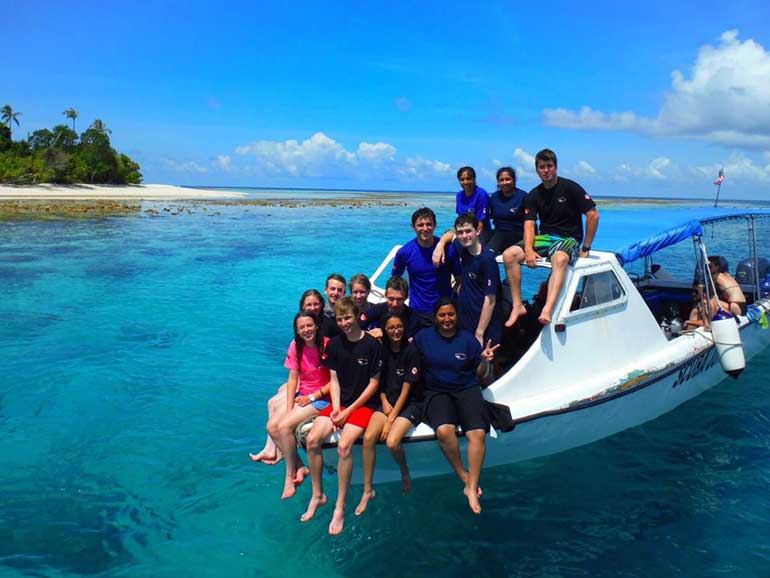
Outlook Expeditions is based in the United Kingdom and organizes adventurous trips for school/youth groups to destinations in the Americas, Europe, Africa, and Asia. Itineraries for each group are created over a 12-month period in collaboration with the outlook team and our staff to accommodate their project requirements.
We provide a PADI Open Water Diver certification, which allows you to dive with groups anywhere in the world to depths of 18 meters. You will learn the fundamentals of scuba diving, including dive equipment and techniques, throughout the course. This qualification is earned by completing confined water dives, knowledge development sessions, and four open water dives.
If you are already an Open water diver then why not further your education and complete your 2 day PADI Advanced Open water course, this will provide you with great skills such as Navigation, Fish ID, Search and Recovery, you have two compulsory dives and then can choose 3 more adventure dives.
We provide a Fish ID Presentation, a responsible snorkelling workshop and fish ID snorkelling session. Students will also be shown how to monitor for coral bleaching & crown of thorns populations and will participate in a coral bleaching / crown of thorns snorkel survey.
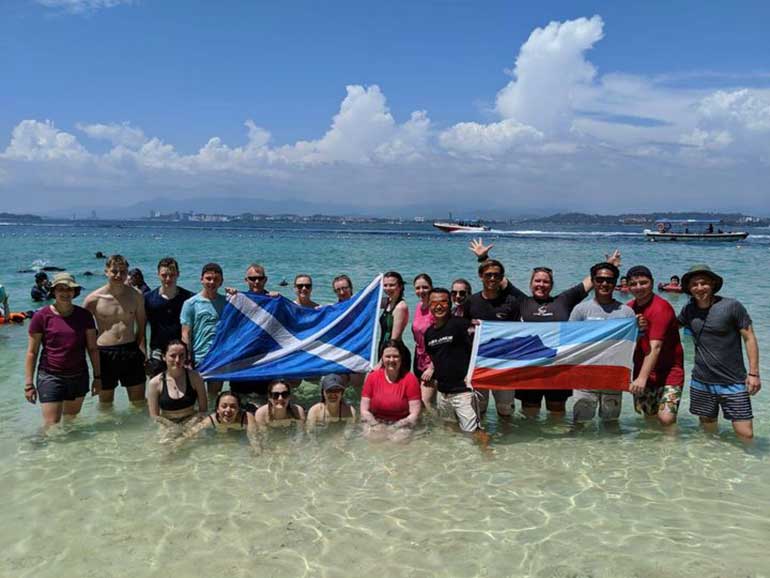
Introduction to the problem of marine debris in Sabah with a presentation, beach clean & snorkel clean up. Marine debris will be reported to Project Aware and coral bleaching results to Green Fins as part of an ongoing monitoring program.
This is dedicated to coral reefs and the project team will introduce students to the work carried out by Reef Check Malaysia and give them an introduction to the techniques used to assess and monitor coral reef health. You will also head out onto the reef looking for indicator species of coral reef health as well as any signs of coral bleaching.
Many visitors come to KK in the hope of spotting sharks & turtles, learn about the threats faced by these amazing animals as well as conducting a snorkel count of both (sightings are frequent but not guaranteed unfortunately!). You’ll also take the opportunity to practise Fish ID & coral reef health assessment during today’s snorkels.
We absolutely LOVE outreach programmes and can’t wait to welcome everyone back once things are safer for travelling.
Check out more about our conservation projects here!
Diving generally requires a number of skills and rules that must be followed in order for an individual to have a safe and enjoyable dive. However, due to the business of daily life, diving vacations and local trips are frequently postponed. When months or years pass between dives, it is time to think about taking a diving refresher course, check out some reasons below to think about why you should do a refresher.
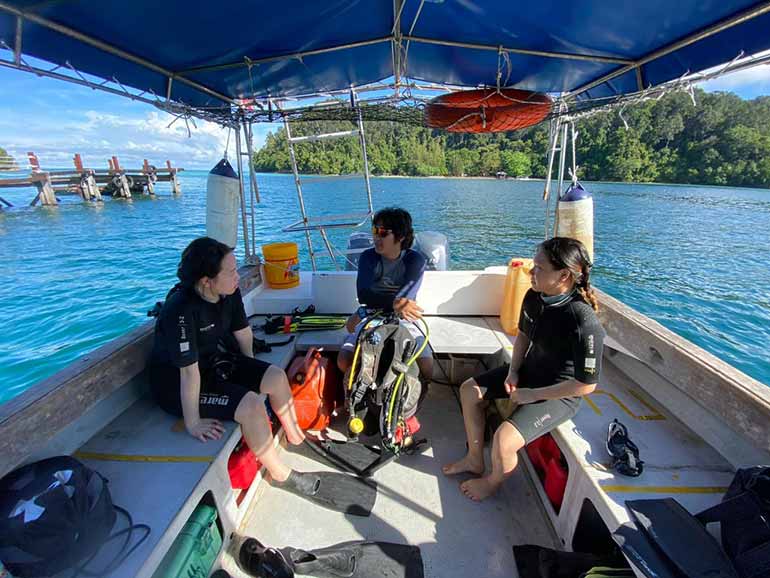
At Scuba Junkie, we usually will ask a guest to sign up for a refresher if they have not been diving in more than 6 months. However this might change depending on the level & number of dives that they have. For example, a new diver who hasn’t been diving at all for at least 6 months is recommended to take the refresher course where as a very experienced diver with over 100 dives might not need to. A responsible diver should be able to determine if they need a refresher course before going diving.
Being an inactive diver for an extended period of time will likely cause you to forget some diving knowledge. The skills & important tips that you once learned may fade away throughout the time if you haven’t been able to dive. This is why a refresher is important because it helps to review all the knowledge that you may have forgotten. Skills that will be taught in a refresher course include: mask clearing, regulator recovery, buoyancy control, buddy check etc. Scuba Junkie conducts our refresher course directly in the ocean. But don’t worry as we only do it at a shallow area where it is shallow enough for you to stand up if needed.
One of the most common problems that people who haven’t dived in a long time face is forgetting how to put their gear together. Diving gear is the most significant aspect of a diver’s underwater support system, thus it’s crucial to set it up properly before entering the water. The instructor will demonstrate how to properly assemble your gear and remind you of the pre-dive safety checks during the refresher session. They will also inform you of the usual blunders to avoid.
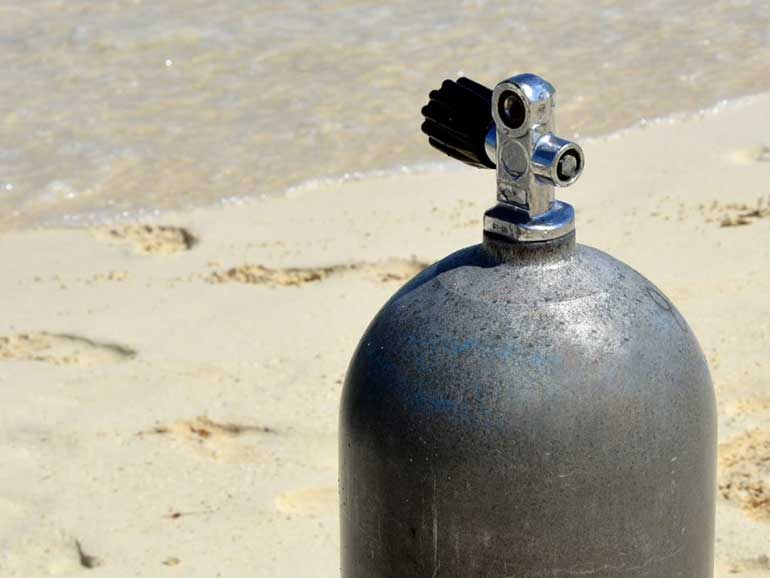
Some divers may develop a few bad diving habits after years of inactivity. They might well forget about proper dive procedures, putting their dive buddy or dive group in danger while diving. A refresher will assist in fine-tuning any potential issues. During the refresher, the instructor will be able to identify and correct any bad diving habits you have. Being a competent diver will make the dive safer and more enjoyable for everyone involved.
As we all know, the world is changing all the time, and the diving world is no exception. An Open Water course from ten years ago may look very different from one we have today. If you haven’t dived in a long time, you may have missed out on the most recent diving technology. The dive computers and cameras are the best examples of this.
If it’s been a while between your dives, take a refresher with Scuba Junkie Kota Kinabalu with one of our professional and experienced staff, its more than just skills, in the long run it will help you build confidence in yourself and fellow divers, making the experience unforgettable!
Blacktip reef sharks are frequently seen when diving in Kota Kinabalu, particularly around Gaya and Mamutik Islands within the KK marine park. They mostly prefer shallow, inshore waters where they feed upon small fish, squid, and crustaceans, which is great as divers don’t have to go too deep to see them and even snorkelers can get the magical experience to see them. The Blacktip reef shark is a docile and inquisitive shark species, so if you ever wanted to snorkel with sharks then this is a great opportunity!
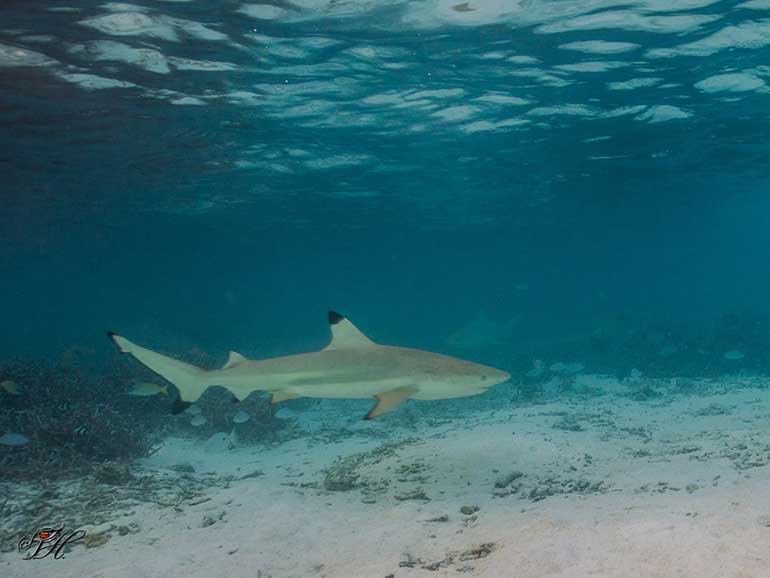
The Blacktip reef shark has a sleek grey-coloured body, rounded snout, horizontal eyes, and tell-tale attractive black tips on all of its fins. Despite their mouth full of serrated teeth, they are known to be docile and timid around humans, so there is nothing to worry about being around these guys!
Size-wise, the blacktip reef shark is a small to medium-sized shark. They can grow to be up to 2 meters long and weigh between 60 and 100kg.
Blacktip reef sharks can live for more than ten years and reach maturity at the age of four to five years.
While most sharks are solo hunters, blacktip reef sharks are often seen traveling in small groups which is helpful for more effective results hunting their prey. Their diet consists of fish, which are abundant around the coral reefs, crustaceans and have even been seen hunting rays! They are extremely fast and skilled predators which normally hunt at night.
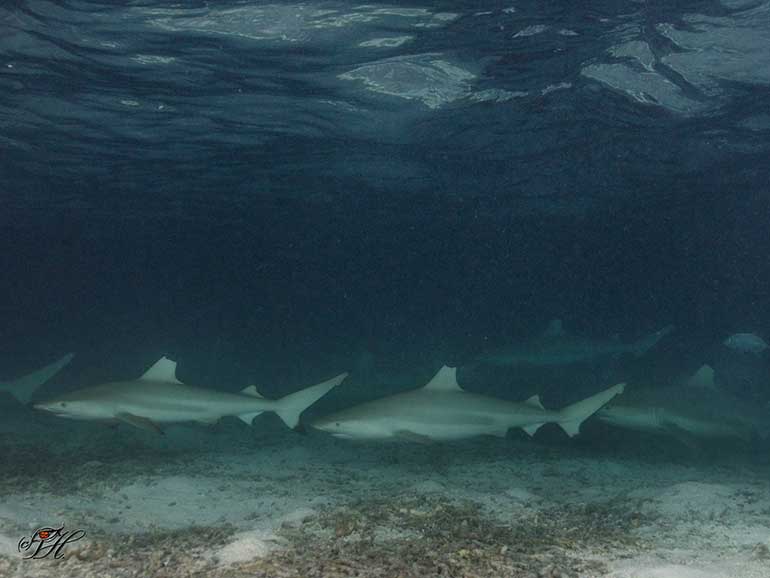
Blacktip reef sharks are viviparous sharks, which means they give birth to live pups instead of eggs. Their gestation period is believed to be around 10-12 months, giving birth to an average of four or five pups per litter. Courtship involves one or more males trailing closely behind a female. Reproductive behavior consists of distinct pairing with an embrace, in which the male grasps the female’s pectoral fin between his teeth and mates belly to belly. Females rest for 8-14 months between pregnancies to rebuild their energy stores.
They can be found all across the world’s oceans. They prefer shallow waters to deep oceans, and can frequently be seen at depths of less than one metre. The preferred habitat for blacktip reef sharks is around coral reefs with clean and warm water, as well as nooks and crannies to hide in. They are quite often seen hanging out in groups.
The blacktip reef shark offers a wonderful opportunity to get up close to safe sharks, they are a very peaceful, non-aggressive species. So leave your fears at home, pack your gear, and jump in to get to know this beautiful shark species here in Kota Kinabalu.
